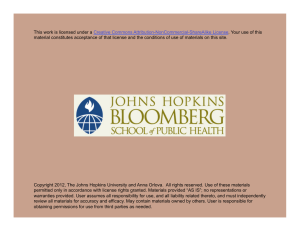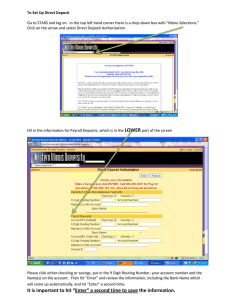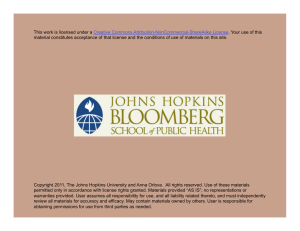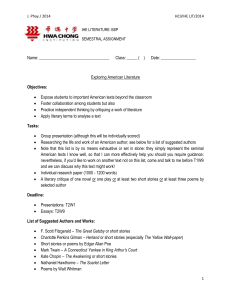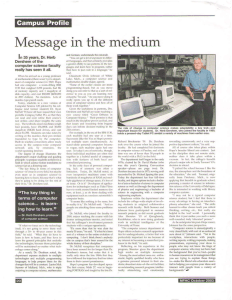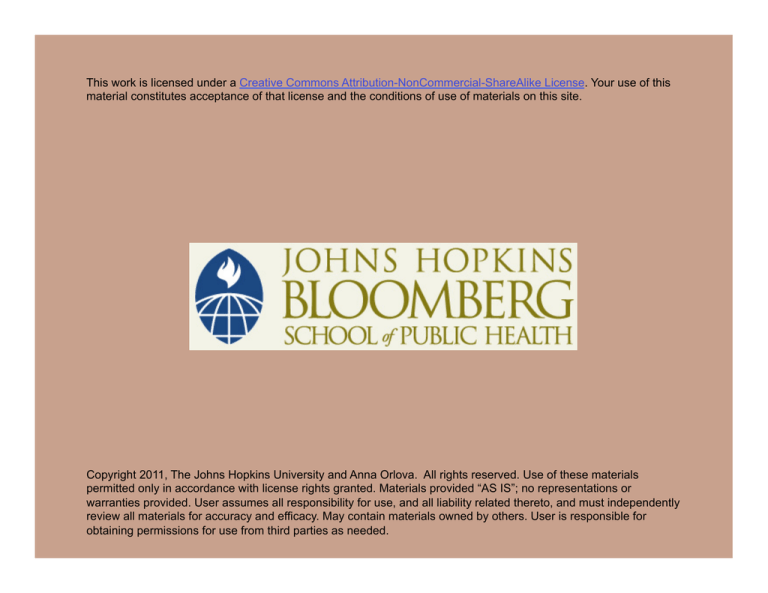
This work is licensed under a Creative Commons Attribution-NonCommercial-ShareAlike License. Your use of this
material constitutes acceptance of that license and the conditions of use of materials on this site.
Copyright 2011, The Johns Hopkins University and Anna Orlova. All rights reserved. Use of these materials
permitted only in accordance with license rights granted. Materials provided “AS IS”; no representations or
warranties provided. User assumes all responsibility for use, and all liability related thereto, and must independently
review all materials for accuracy and efficacy. May contain materials owned by others. User is responsible for
obtaining permissions for use from third parties as needed.
Section D
HIT Standardization Phases and Entities (Continued)
Standardization Phases
Needs and priorities
What should be accomplished?
3
Setting Priorities in Standards for Public Health
4
Setting Priorities in Standards for Public Health
2015–2016
Future CMS rule
2013–2016
Future CMS rule
2011–2012
Current CMS NPRM
Source: W. Suarez, et.al. “Review of CMS Meaningful Use NPRM and ONC Standards and Certification IFR:
Implications for Public Health.” Presentation at JPHIT-PHDSC Webinar, February 4, 2010. Public Domain.
5
Setting Priorities in Standards for Public Health
The following pubic health programs are included in the Meaningful
Use of Health IT—Stage 1 (2011):
- Laboratory data reporting to public health agencies
- Immunization data reporting to public health agencies
- Syndromic surveillance data reporting to public health agencies
IF
Public health agencies can electronically receive them …
Source: W. Suarez, et.al. “Review of CMS Meaningful Use NPRM and ONC Standards and Certification IFR:
Implications for Public Health.” Presentation at JPHIT-PHDSC Webinar, February 4, 2010.
6
Standardization Phases
Standards development and maintenance
What are the standards?
7
Standard Development and Maintenance
Standard Development Organizations (SDOs)
- SNOMED (clinical terminology)
- LOINC (laboratory standards)
- NCPDP (drugs standards)
- DICOM (images standards)
- HL7 (messaging and structured document standards)
Data Content Committees (DCCs)
- National Uniform Billing Committee (NUBC)
-
-
National Uniform Claims Committee (NUCC)
CDISC (clinical trial data reporting to FDA)
8
Standardization Phases
Standards harmonization
What standards to use?
9
Standard Harmonization
Standard Harmonization Organizations (SHOs)
- Health Information Technology Standards Panel (HITSP),
www.hitsp.org
- Integrating the Healthcare Enterprise (IHE), www.ihe.net
10
HITSP, 2005–2009
Discussion Document
Standards Harmonization Technical
Committees Update
Report to the Healthcare Information Technology
Standards Panel
Contract HHSP23320054103EC
Health Information Technology
Standardization Panel (HITSP)
includes 206 member
organizations:
-
-
-
-
URL: http://www.hitsp.org
17 SDOs (8%)
161 non-SDOs (79%)
18 governmental bodies (8%)
10 consumer groups (5%)
11
HITSP Framework for Interoperability Specification
(Standards harmonization document)
From: use case (scenarios, business actors, and business and
functional/interoperability requirements)
To: interoperability specification supporting the use cases (technical
actors, transactions, standards)
12
Setting Priorities in Standards for Public Health
13
National Biosurveillance Use Case
Charge: “transmit essential data from electronically enabled
healthcare to authorized public health agencies in real-time”
14
Biosurveillance Use Case: Workflow
15
Biosurveillance
16
Biosurveillance
17
Biosurveillance
18
Biosurveillance Interoperability Specification
Source: HITSP and American National Standards Institute (ANSI). All Rights Reserved.
19
Standard Harmonization
Standard Harmonization Organizations (SHOs)
- Health Information Technology Standards Panel (HITSP),
www.hitsp.org
- Integrating the Healthcare Enterprise (IHE), www.ihe.net
20
Standardization Phases
Trial implementation and testing
Show what can be accomplished
21
Standards Trial Implementation
22
IHE
Providers, PUBLIC HEALTH and
Software Developers
Working Together to Deliver
Interoperable Health Information Systems
in the Enterprise
and Across Care Settings
PHDSC was invited to form a
public health domain at IHE
23
Integrating the Healthcare Enterprise (IHE)
White papers
Content profiles
Technical frameworks
Testing tools
Integration profiles
24
Health IT Vendors Involved in IHE
25
Standards Testing IHE Connectathon
300+ participants, 120+ systems
60+ systems developers
Four domains
- Cardiology
-
-
-
IT infrastructure
Patient care coordination
Radiology
2800+ monitored test cases
Photo source: IHE.net. Permission pending.
26
Public Health Testing at IHE
Develop HIT testing methods and tools for public health
- Early hearing detection and intervention
- Vital records
- Cancer registries
27
Standardization Phases
Certification of standards-based products
Certify standards-based IT products
28
Standard Certification
Certification Commission for Health Information Technology (CCHIT)
- www.cchit.org
29
Public Health Systems Certification
Develop HIT certification for public health
through public health functional profile
- Early hearing detection and
intervention
- Vital records
- Cancer
- Communicable diseases
30
PHDSC Business Case
PHDSC Business Case: HIT Standardization Phases, Products and Entities
HIT standardization phases
Needs and
priorities
Development and
maintenance
Selection and
Harmonization
Testing/trial
implementation
Goals
What should be
accomplished?
What are the
standards?
What standards
to use?
Show what
can be
accomplished
HIT standards
and interoperability
framework
development
entities
Standards
documents
HIT policy
committee
SDOs—for
HIT standards
example, HL7,
committee
SNOME (IHTSDO),
(former AHIC) to LOINC, ASC X12,
be superseded NUBC, ISO TC215)
pending ONC
decisions
Use cases
(description of
the health
information
exchanges)
On-going activities ( 2008-now)
New activities (2010-11)
Future activities
IHE—formerly
HITSP, to be
superseded
pending ONC
decisions
NHIN
IHE
Interoperability
specifications
Standards
Technical
frameworks
Integration
profiles
Certification
Certify
Deploy
standardsstandardsbased products based products
Certification
entities
(CCHIT,
Drummond
Group, Inc)
Functional
profiles
Test reports
Deployment
Certification
criteria
Proposed
IHE and PHDSC
deployment
workshops
Deployment
reports
Developed methodology for public health participation in HIT standards development
and harmonization
Develop methodology for public health participation in HIT product testing and
certification
Develop methodology for evaluation of standard-based HIT products
(HIT adoption)
31
ONC Standards and Interoperability Framework
Source: Fridsma D. (September 21, 2010).
Standards and Interoperability Framework: Principles and Processes. HIT Standards Committee. HHS.
32
PHDSC Business Case
PHDSC Business Case: HIT Standardization Phases, Products and Entities
HIT standardization phases
Needs and
priorities
Development and
maintenance
Selection and
Harmonization
Testing/trial
implementation
Goals
What should be
accomplished?
What are the
standards?
What standards
to use?
Show what
can be
accomplished
SDOs—for
example, HL7,
SNOME (IHTSDO),
LOINC, ASC X12,
NUBC, ISO TC215)
IHE—formerly
HITSP, to be
superseded
pending ONC
decisions
HIT standards
and interoperability
framework
development
entities
Standards
documents
Certification
Deployment
Certify
Deploy
standardsstandardsbased products based products
HIT policy
committee
HIT standards
committee—
formerly AHIC,
to be
superseded
pending ONC
decisions
Use cases
(description of
the health
information
exchanges)
NHIN
IHE
Interoperability
specifications
Standards
Technical
frameworks
Integration
profiles
Certification
entities
(CCHIT,
Drummond
Group, Inc)
Functional
profiles
Test reports
Certification
criteria
Proposed
IHE and PHDSC
deployment
workshops
Deployment
reports
33
Standardization Phases
Deployment of standards-based products
Deploy standards-based IT products
34
Standard Deployment
US
35


